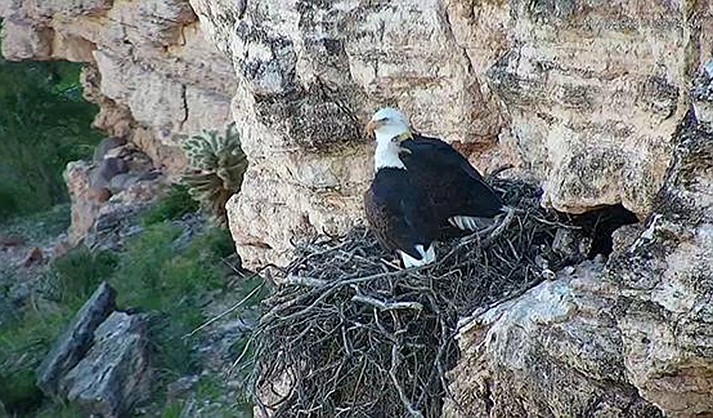Restrictions in place as bald eagle breeding season begins
Tips for visiting eagle areas
Arizona’s bald eagles are back, and they will soon be preparing for the next generation of eagles at breeding sites statewide.
To assist with the state’s continued bald eagle population growth, the Arizona Game and Fish Department (AZGFD) encourages outdoor recreationists, aircraft pilots, drone operators and motorized paragliders to do their part by not disturbing the state’s 94 eagle breeding areas.
The closure plan does not include the Verde River below Sycamore Canyon, which typically has a breeding pair. Those eagles have not nested yet. If they do, the area will be closed to foot traffic.
“Arizona’s bald eagles are hard at work preparing their nest for what we hope will be a productive breeding season,” said Kenneth “Tuk” Jacobson, bald eagle management coordinator. “The birds nest, forage and roost at rivers and lakes that are also popular recreation spots. That’s why we must be vigilant to help protect the birds and ensure their populations statewide continue to flourish. That success wouldn’t be possible without the cooperation of outdoor recreationists who respect the closures during the breeding season.”
During the 2022 breeding season, 78 young hatched, and 61 reached the important milestone of their first flight, known as fledging.
Pilots are reminded to maintain the FAA-recommended 2,000-foot above ground level advisory when flying over bald eagle habitat, while drones and paragliders are asked to avoid the areas completely. Bald eagles are sensitive to even short durations of low-flying aircraft activity near their nests, and just a few minutes of disturbance can lead to a nesting failure.
AIRSPACE ADVISORY
Statewide
The Federal Aviation Administration (FAA) has established a 2,000-foot above ground level (AGL) advisory along the Salt and Verde river drainages and lakes such as Lake Pleasant, Roosevelt Lake and Alamo Lake. These areas are designated on the Phoenix Sectional Aeronautical map and also include Alamo Lake, Ashurst Lake, Greer Lakes, Crescent Lake, Luna Lake, Show Low Lake, Chevelon Canyon Lake, Woods Canyon Lake, Lake Mary, Dogtown Reservoir, White Horse Lake and the Bill Williams National Wildlife Refuge. Special brochures for pilots regarding this advisory can be obtained by calling the Arizona Department of Transportation or AZGFD's Terrestrial Wildlife branch at 623-236-7506.
SEASONAL CLOSURES
Verde River
• A closure for the Verde River below Sycamore Canyon Wilderness is not planned this year unless the eagle pair resumes nesting. Verde River below Sycamore Canyon Wilderness may be closed to foot and vehicle entry from Dec. 1 to June 15. Floating through is allowed, but contact the Coconino National Forest, Red Rock Ranger District office for more information at 928-203-7500 or 928-203-2900.
• Verde River near Chasm Creek is closed to foot and vehicle entry from Dec. 1 to June 30. Floating through is allowed. Contact the Prescott National Forest, Verde Ranger District, at 928-567-4121.
• Verde River near Cold Water Creek, allows watercraft to float through but no stopping on the river or landing is allowed Dec. 1 to June 30. Contact the Prescott National Forest, Verde Ranger District, at 928-567-4121.
• Verde River upstream of the East Verde confluence is closed to vehicle and foot entry from Dec. 1 to June 30. Floating through is allowed, but no stopping in the river or landing is allowed. Contact the Tonto National Forest, Cave Creek Ranger District, at 480-595-3300.
• Verde River near Mule Shoe Bend allows watercraft to float through but no stopping in the river or landing is allowed from Dec. 1 to June 30. Contact the Tonto National Forest, Cave Creek Ranger District, at 480-595-3300.
• Verde River below Bartlett Dam is closed to foot or vehicle entry from Dec. 1 to June 30. Floating through is allowed, but no stopping in the river or landing is allowed. Contact the Tonto National Forest, Cave Creek Ranger District, at 480-595-3300.
• Verde River at the Needle Rock Recreation Area is closed to foot and vehicle entry on portions of the west side of the river from Dec. 1 to June 30. Floating through is allowed, but no stopping in the river or landing on the east side of the river is allowed. Contact the Tonto National Forest, Cave Creek Ranger District, at 480-595-3300.
Tonto Creek
• Tonto Creek from Gisela to 76 Ranch is not planned to be closed to vehicle, foot entry, and floating through from Dec. 1 to June 30, unless the eagle pair resumes nesting within the closure area. Contact the Tonto National Forest, Tonto Basin Ranger District, at 928-467-3200.
• Tonto Creek inlet to Roosevelt Lake is closed to vehicle and foot entry within 1,000 feet of the nest on land and to watercraft within 300 feet on water from Dec. 1 to June 30. Contact the Tonto National Forest, Tonto Basin Ranger District, at 602-225-5395.
Salt River
• Salt River from Horseshoe Bend to Redmond Flat allows watercraft to float through, but no stopping in the river or landing is allowed from Dec. 1 to June 30. Contact the Tonto National Forest, Globe Ranger District, at 928-402-6200.
• Salt River near Meddler Point is closed to vehicle and foot entry within 1,000 feet of the nest on land and to watercraft within 300 feet on water from Dec. 1 to June 30. Contact the Tonto National Forest, Tonto Basin Ranger District, at 602-225-5395.
• Salt River below Stewart Mountain Dam is closed to vehicle or foot entry on the south side of the river from Dec. 1 to June 30. Floating through is allowed. Contact the Tonto National Forest, Mesa Ranger District, at 480-610-3300.
• Salt River near Goldfield-Kerr Fire Station is closed to foot and vehicle entry on the north side of the river from Dec. 1 to June 30. Floating through is allowed. Contact the Tonto National Forest, Mesa Ranger District, at 480-610-3300.
Crescent Lake
A portion of land west of the lakes is closed to all entry from March 1 through Aug. 31. Contact the Apache-Sitgreaves National Forest, Springerville Ranger District, at 928-333-6200.
Fool Hollow Lake
A portion of the shoreline may be closed to foot entry from Dec. 1 through June 31. Contact the Apache-Sitgreaves National Forest, Lakeside Ranger District, at 928-368-2100.
Greer Lakes
(Tunnel and River). Depending on the nesting location, portions of the lakes may be closed to watercraft and a portion of the shoreline may be closed to foot entry from March 1 through July 31. Contact the Apache-Sitgreaves National Forest, Springerville Ranger District, at 928-333-6200.
Horseshoe Lake
Depending on the nesting location, a portion of the lake may be closed from Dec. 1 to June 30. Contact AZGFD at 623-236-7506.
Lake Pleasant
No vehicle, watercraft or foot entry is allowed into a portion of the Lower Agua Fria Arm from Dec. 15 to June 15. Contact Maricopa County Parks and Recreation at 928-501-1710.
Luna Lake
Depending on the nesting location, the portion of land to the north or south of Luna Lake may be closed to vehicle and foot traffic from Jan. 1 to June 15. Contact the Apache National Forest, Alpine Ranger District, at 928-339-5000.
Lynx Lake
Depending on the nesting location, a portion of trail on the lake’s east side is closed to vehicle and foot traffic from Dec. 1 to June 30. Contact the Prescott National Forest, Bradshaw Ranger District, at 928-443-8000.
Show Low Lake
A portion of the lake may be closed to watercraft and a portion of the shoreline may be closed to foot entry from January 1 through July 31. Contact the Apache-Sitgreaves National Forest, Lakeside Ranger District, at 928-368-2100.
Woods Canyon Lake
A portion of the shoreline is closed to foot entry from March 1 through Aug. 31. Contact the Apache-Sitgreaves National Forest, Black Mesa Ranger District, at 928-535-7300.
TIPS FOR VISITING EAGLE AREAS
If you are visiting bald eagle country, an advance call to the local land management agency, such as the local U.S. Forest Service district office or AZGFD, may help to plan your trip to avoid disturbing bald eagles. By following these simple guidelines, we can all help ensure that our living wildlife legacy will last for generations to come:
• Enjoy bald eagles from outside the closures, which are marked with signs and/or buoys. Watch from a distance using a spotting scope, binoculars or telephoto camera lens. If the eagles are persistently watching you, observation at a greater distance is advised.
• Anyone approached by a nestwatcher and asked to cease an activity or leave a closed area should comply. A few good places to see bald eagles without disturbing them (during December and January) are at Lake Mary and Mormon Lake near Flagstaff, on the Verde Canyon Train in Clarkdale, or Roosevelt Lake.
• Bald eagles protecting an active nest will let you know if you are too close. If a bald eagle is vocalizing and circling the area frantically, you are too close and need to leave the area quickly. Bald eagles incubating eggs or brooding small young should never be off the nest for more than 15 minutes.
• Help from anglers is especially needed. Fishing line and tackle have killed two nestlings and been found in two-thirds of all bald eagle nests in the state. Biologists remove these lethal hazards from nests and/or entangled nestlings every year. Discard any fishing line properly in specially-marked recycling containers or at fishing stores. Also, use fresh line that isn’t old and brittle. Use the correct test line for the fish you are trying to catch. Also, do not cut the line when an undesirable fish is caught and return it to the water with the hook and line attached.
• Duck hunters should scout out their hunting area to ensure that bald eagles are not nesting nearby.
You can help conserve and protect bald eagles, and conservation research and recovery efforts, by reporting any harassment or shooting of bald eagles. Call the Operation Game Thief hotline at 800-352-0700 or U.S. Fish and Wildlife Service Law Enforcement at 480-967-7900.
AZGFD’s bald eagle management efforts are supported by the Heritage Fund, an initiative passed more than 20 years ago to provide for wildlife education and conservation through Arizona lottery ticket sales.
SUBMIT FEEDBACK
Click Below to:




